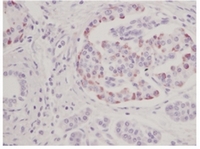IL10 Rabbit Polyclonal Antibody
Other products for "IL10"
Specifications
| Product Data | |
| Applications | ELISA, FN, IHC, WB |
| Recommended Dilution | Neutralization: To yield one-half maximal inhibition [ND50] of the biological activity of Human IL-10 (1.0 ng/ml), a concentration of 1.2-1.8 µg/ml of this antibody is required. Indirect ELISA: To detect Human IL-10 by Indirect ELISA (using 100 µl/well antibody solution) a concentration of 0.5-2.0 µg/ml of this antibody is required. This antigen affinity purified antibody, in conjunction with compatible secondary reagents, allows the detection of at least 0.2-0.4 ng/well of recombinant Human IL-10. Sandwich ELISA: To detect Human IL-10 by Sandwich ELISA (using 100 µl/well antibody solution) a concentration of 0.5-2.0 µg/ml of this antibody is required. This antigen affinity purified antibody, in conjunction with Biotinylated Anti-Human IL-10 (Cat.-No PP1032B) as a detection antibody, allows the detection of at least 0.2 - 0.4 ng/well of recombinant Human IL-10. Western Blot: To detect Human IL-10 by Western Blot analysis this antibody can be used at a concentration of 0.1-0.2 µg/ml. Used in conjunction with compatible secondary reagents the detection limit for recombinant Human IL-10 is 1.5-3.0 ng/lane, under either reducing or non-reducing conditions. Immunohistochemistry: This antibody stained formalin-fixed paraffin-embedded sections of Human pancreas adenocarcinoma tissue. The recommended concentration is 5.0 µg/ml with an overnight incubation at 4°C. An HRP-labeled polymer detecttion system was used with an alcohol-soluble AEC chromogen. Heat induced antigen retrieval with a pH 6.0 Sodium Citrate buffer is recommended. Tissue samples were provided by the Cooperative Human Tissue Network, which is funded by the National Cancer Institute. |
| Reactivities | Human |
| Host | Rabbit |
| Clonality | Polyclonal |
| Immunogen | Highly pure (>98%) E.coli derived recombinant Human IL-10 (Cat.-No PA084) |
| Specificity | Recognizes Human IL-10. Other species not tested. |
| Formulation | PBS, pH 7.2 without preservatives State: Aff - Purified State: Lyophilized (sterile filtered) purified Ig fraction |
| Reconstitution Method | Centrifuge vial prior to opening. Restore in sterile water to a concentration of 0.1-1.0 mg/ml. |
| Purification | Affinity Chromatography employing immobilized hIL-10 matrix |
| Conjugation | Unconjugated |
| Storage | Prior to reconstitution store at 2-8°C. Following reconstitution store undiluted at 2-8°C for one month or (in aliquots) at -20°C for longer. Avoid repeated freezing and thawing. |
| Stability | Shelf life: one year from despatch. |
| Predicted Protein Size | ~150 KDa |
| Gene Name | interleukin 10 |
| Database Link | |
| Background | Interleukins (ILs) are a large group of cytokines that are produced mainly by leukocytes, although some are produced by certain phagocytes and auxiliary cells. ILs have a variety of functions, but most function to direct other immune cells to divide and differentiate. Each IL acts on a specific, limited group of cells through a receptor specific for that IL. Human IL10 is a non glycosylated polypeptide consisting of 178 amino acids. There is 73% homology between the human and mouse IL10 proteins, however, the human IL10 acts on both human and mouse target cells, while the mouse IL10 has species specific activity. The cellular sources of IL10 are CD4+ T cells and T cell clones, thymocytes, B cells and B cell lymphomas, macrophages, mast cell lines and keratinocytes. IL10 will stimulate the growth of stem cells, mast cells and thymocytes. IL10 enhances cytotoxic T cell development, and costimulates B cell differentiation and immunoglobulin secretion. IL10 inhibits cytokine production by macrophages and suppresses macrophage class II MHC expression. The human IL10 gene is on human chromosome 1. |
| Synonyms | IL-10, CSIF, TGIF |
| Reference Data | |
| Protein Families | Druggable Genome, ES Cell Differentiation/IPS, Secreted Protein |
| Protein Pathways | Allograft rejection, Asthma, Autoimmune thyroid disease, Cytokine-cytokine receptor interaction, Jak-STAT signaling pathway, Systemic lupus erythematosus, T cell receptor signaling pathway |
Documents
| Product Manuals |
| FAQs |
| SDS |
{0} Product Review(s)
0 Product Review(s)
Submit review
Be the first one to submit a review
Product Citations
*Delivery time may vary from web posted schedule. Occasional delays may occur due to unforeseen
complexities in the preparation of your product. International customers may expect an additional 1-2 weeks
in shipping.






























































































































































































































































 Germany
Germany
 Japan
Japan
 United Kingdom
United Kingdom
 China
China





